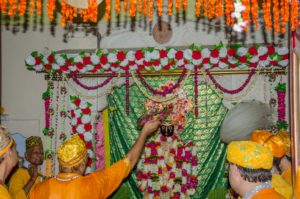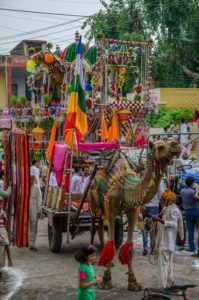The climatic conditions and topography of a region play a significant role in defining the socio-cultural practices of its inhabitants. This holds especially true for India, where for centuries, a majority of festive celebrations and religious observances have been centred around different seasonal periods of the year.
 India’s latitudinal and longitudinal positioning predisposes most of its geographical territories to tropical climatic conditions. The British, who established their empire over the subcontinent (and subsequently ruled it for 200 years) were quick to realise that the climate in the new colony was certainly not their cup of tea. While on one hand, they commanded a vast territorial expanse with unprecedented military power; on the other, they found themselves utterly helpless in carrying out daily affairs under the blazing Indian sun. Thus they resorted to the hills, the region bearing the closest resemblance to the picturesque country landscapes back home in England. The general disdain which the British held for India’s tropical conditions, often took rather absurd forms. Indians were believed to possess a general tendency to submit themselves to despotic rule because of the tropical climatic conditions in which they lived. Moreover, the climate was also seen as an apt means to justify the ‘barbarous’, ‘rebellious’ and ‘unruly’ tendencies of the Indians, along with the widespread lack of organisation and order.
India’s latitudinal and longitudinal positioning predisposes most of its geographical territories to tropical climatic conditions. The British, who established their empire over the subcontinent (and subsequently ruled it for 200 years) were quick to realise that the climate in the new colony was certainly not their cup of tea. While on one hand, they commanded a vast territorial expanse with unprecedented military power; on the other, they found themselves utterly helpless in carrying out daily affairs under the blazing Indian sun. Thus they resorted to the hills, the region bearing the closest resemblance to the picturesque country landscapes back home in England. The general disdain which the British held for India’s tropical conditions, often took rather absurd forms. Indians were believed to possess a general tendency to submit themselves to despotic rule because of the tropical climatic conditions in which they lived. Moreover, the climate was also seen as an apt means to justify the ‘barbarous’, ‘rebellious’ and ‘unruly’ tendencies of the Indians, along with the widespread lack of organisation and order.
In complete contrast to this perception, the summer season in the Indian tradition abounds within itself a host of joyous celebrations. Summer roughly corresponds to the months of Vaishaka, Jyestha and Ashadha in the Hindu calendar. The third day of the brighter half of Chaitra is observed as Akshaya Tritiya- a day considered most auspicious for purchasing gold. Vaishnava shrines across Northern and Eastern India in particular mark this as the first day of ‘Chandan Yatra’. Being a natural coolant, sandalwood forms a major part of the offerings made at temples around this time. For the forty-two day period following Akshaya Tritiya, the deities in most Vaishnava shrines are covered in sandalwood paste and are offered ceremonial baths to cool off in the hot months. The Chandan Yatra festival assumes special significance in Puri, where the building of the chariots for Rath Yatra commences.
The eleventh day of the brighter half of Jyeshtha corresponds to the observance of the Nirjala Ekadashi fast. Ekadashi holds great significance for the devotees of Vishnu, who fast and undertake special spiritual practices. Though the fast is observed twice in every month (once each in the waxing and waning phases of the moon), the Ekadashi in the month of Jyeshtha requires devotees to not just abstain from particular kinds of food, but from water as well. Considering the prevailing heat the conditions the fast imposes are certainly harsh, but the way in which the true essence of fasting is realised is indeed inspiring. It is a common practice for devotees who undertake the Nirjala Ekadashi fast to stand all day on roads and places frequented by travellers, under the blazing sun, to distribute water to all passers-by. A great degree of detachment is thus inflicted upon the observer of the fast, who not only abstains from consuming water but wholeheartedly offers it to anyone in need.
The month of Jyeshtha marks the beginning of festivities which ultimately culminate in Puri’s famed Jagannath Rath Yatra. On the full moon day of June, Jagannath, along with His sister Subhadra and elder brother  Balabhadra, is brought out from the sanctum and placed on a specially erected platform for a sacred bathing ceremony. This festival, known as Snana Yatra, has been observed in Puri since antiquity. In the sweltering heat of the coastal town of Puri, Jagannath is cooled down with a variety of scented waters, fruit juices, fragrant oils and sandalwood paste, before being taken back to His shrine. Jagannath along with His siblings is adorned on this day in ‘Haati Vesha’ or the garb of an elephant, in reminiscence of an intriguing legend. It is believes that once, a mendicant who was a great devotee of Lord Ganesha visited Puri during the period of Snana Yatra. Quoting his exclusive devotion to Ganesha, he refused to bow down before Jagannath. However, on visiting the shrine, to his utter amazement he saw Jagannath had assumed the form of Ganesha to bless him. Seen on another level, the adorning of Jagannath in the ‘Haati Vesha’ stands as a testimony to how different streams of belief and thought have synthesised, integrated and brought forth absolutely beautiful expressions of harmony in the Indian tradition.
Balabhadra, is brought out from the sanctum and placed on a specially erected platform for a sacred bathing ceremony. This festival, known as Snana Yatra, has been observed in Puri since antiquity. In the sweltering heat of the coastal town of Puri, Jagannath is cooled down with a variety of scented waters, fruit juices, fragrant oils and sandalwood paste, before being taken back to His shrine. Jagannath along with His siblings is adorned on this day in ‘Haati Vesha’ or the garb of an elephant, in reminiscence of an intriguing legend. It is believes that once, a mendicant who was a great devotee of Lord Ganesha visited Puri during the period of Snana Yatra. Quoting his exclusive devotion to Ganesha, he refused to bow down before Jagannath. However, on visiting the shrine, to his utter amazement he saw Jagannath had assumed the form of Ganesha to bless him. Seen on another level, the adorning of Jagannath in the ‘Haati Vesha’ stands as a testimony to how different streams of belief and thought have synthesised, integrated and brought forth absolutely beautiful expressions of harmony in the Indian tradition.
In the period between Snana Yatra and Rath Yatra, Jagannath is confined to the care of select priests in the temple and does not give Darshan to His devotees. It is popularly believed that following the Snana Yatra, The Lord falls sick and is not worshipped in his idol form. Instead, worship is offered to the Patta Chitra (traditional paintings from Odisha) depictions of Subhadra, Balabhadra and Jagannath. Over this period, Jagannath’s worship is not conducted by high-standing Brahmin priests, but by the descendants of tribal chieftains who initially carried out the ceremonies before the integration of Jagannath worship into mainstream Hinduism. The Lord’s splendour is restored after a period of roughly fifteen days, when he comes out in His full glory for the Rath Yatra festival.
Cultural synthesis forms the basis of virtually all festivals which are observed during the Indian summer. The discomfort inflicted by the climatic conditions, are thus, sidelined and people are urged to see the inherent unity in all living entities. Summer thus, ceases to be a period of harshness. The human spirit of integrity and harmony are seen in its full blossom during this period, just like the beautiful yellow flowers of the laburnum tree.
Author- Piyush Kukrety


It?s hard to come by knowledgeable people on this subject, however, you
With thanks! Valuable information!
With thanks! Valuable information!
With thanks! Valuable information!
With thanks! Valuable information!
With thanks! Valuable information!
Don’t wear seat belts lest you drown in your own urine?
Awesome! Its in fact amazing paragraph, I have got much clear idea regarding from this piece of https://php665.com/
Hello. impressive job. I did not anticipate this. https://php665.com/
Black on black in the Charger I’m creepin’ Rub me the right way, you might get a genie B.o.B, black Houdini